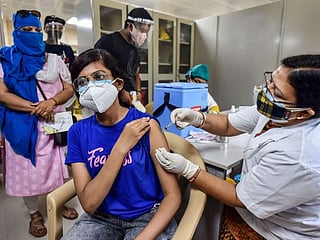Floating corpses in India: Can I catch COVID-19 from water?
Experts weigh in on fears of coronavirus transmission from bodies in rivers

Also In This Package
COVID -19: India’s vaccine programme needs a boost

COVID-19: Indian states under lockdown or similar curbs

Photos: Nepal overwhelmed by surge of COVID infections

See: Jumbo Mumbai COVID-19 hospital treats thousands

How dangerous to the living are the decomposing human bodies — many of them suspected of having died of COVID-19 — seen on India’s rivers or buried near the river banks?
Speculation is rife: are they the remains of COVID-19 victims? If so, how dangerous is it to the living? Will they contract the virus? The Ganges (more commonly known in India as Ganga) and Yamuna rivers are key sources of drinking water for many villages, local bodies along the rivers.
Crematoriums overwhelmed, firewood running out
Crematoriums in India had been reportedly overwhelmed, with certain localities failing to keep pace with the deaths — cremations of up 4,000 people a day following death due to COVID-19 had been reported. Are the bodies evidence of a desperate act of relatives of people whose COVID cases prior to death had not been reported to Indian health authorities, and were therefore under-counted?
Is it the case that the initial tallies of cases in India were erroneously low — which meant that COVID-stricken areas received the shorter end of resources and funding, and with low case counts affecting individual behaviour? Experts have weighed in as bodies of suspected COVID-19 patients are being fished out of the Ganges and Yamuna. One question swirling in the minds of many is this:
Can coronavirus transmission happen through water?
“(It's) not theoretically impossible,” US virologist Dr Jeremy Kamil told Gulf News. “Generally, dead bodies don’t spread pathogens the way that live people do/can,” he said.
Generally, dead bodies don’t spread pathogens the way that live people do/can. Viruses can’t replicate in dead cells.Dr Jeremy Kamil, a US virologist
Dr Kamil is a recognised virology expert, having done numerous peer-reviewed research on molecular virology published in PNAS, The Journal of Experimental Medicine, PLoS and Science, among others.
“Viruses can’t replicate in dead cells,” he added. “So at that point, the dead body is growing bacteria and other stuff. Not viruses.”
Can dead bodies transmit viruses?
“By the time the bodies rot enough to break apart — and release virus — the virus itself would have ‘rotted’ too,” said Dr Kamil, an associate professor of Microbiology and Immunology at the Louisiana State University (LSU) Health Shreveport.
With viruses like Ebola, you do see high infection rates in people who handle the freshly dead body. That’s because there is a lot virus in the blood. This is not the case with SARS-COV-2. It stays in the respiratory system and the gut.Dr Jeremy Kamil, associate professor of Microbiology and Immunology at the Louisiana State University (LSU) Health Shreveport.
“With viruses like Ebola, you do see high infection rates in people who handle the freshly dead body. That’s because there is a lot virus in the blood. This is not the case with SARS-COV-2. It stays in the respiratory system and the gut,” Dr Kamil said.
What if people swim or drink water from a river with dead bodies?
“If you’re drinking water that had dead bodies in it, there are other issues I am worried about.” That, he said, includes possible bacterial infections.
Dr Kamil has weighed in on what Indian experts had earlier pointed out — that coronavirus transmission cannot happen through water.
Satish Tare, professor at IIT-Kanpur, told local media that while dumping of dead bodies in the Ganges and Yamuna, its tributaries or sub-tributaries is a "serious matter”, coronavirus transmission through water is “not a concern”.
Tare said dumping bodies in the Ganges or its tributaries is "not new", and has come down significantly in the last 10-15 years. Dumping of bodies, he said, primarily leads to pollution of rivers.
What happens to people who collect the dead bodies?
Even if the bodies of suspected COVID-19 patients were fished out, there is a lot of “dilution” that happens (during the flow of water), said Prof Tare, who teaches environmental engineering, water quality and wastewater treatment. “The effect may not be significant,” he said.
If the water is passed for water supply, then it passes through the water supply system. Normal treatment takes care of it.Satish Tare, professor at IIT-Kanpur
What if the water goes into the water supply to communities?
"If the water is passed for water supply, then it passes through the water supply system. Normal treatment takes care of it,” said Prof Tare told Indian media.
What’s the most common route of COVID-19 transmission?
It’s been established that close contact and exposure to a COVID-19 patient pose the highest risk of viral transmission. Muge Cevik, a virology clinician and scientist focussing on infectious diseases, has explained that in general, COVID-19 transmission is facilitated by the following:
So, the longer the time you spend with an infected person and the larger the gathering, higher the risk.
What is the likelihood of catching the virus outdoors?
Dr Cevik cited contact-tracing studies which suggest that transmission risk is 20 times higher in indoor settings compared with outdoor environments. “The risk is not zero but significantly lower.”
“And we know that the majority of transmission (more than 90%) occurs indoors. Sharing the same sleeping space, frequent daily contact, engaging in group activities such as dining are high risk. So, the risk increases with longer and frequent exposure, close proximity, of contacts.”
“The small number of cases where outdoor transmission might have occurred were associated with close interactions, particularly extended duration, or settings where people mixed indoors alongside an outdoor setting.”
Sign up for the Daily Briefing
Get the latest news and updates straight to your inbox






